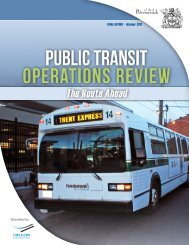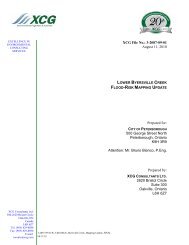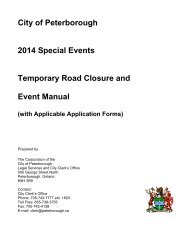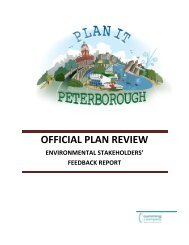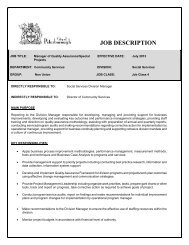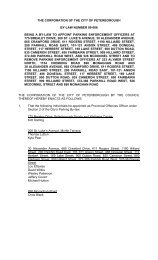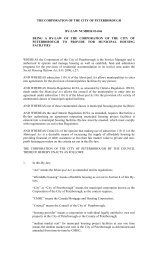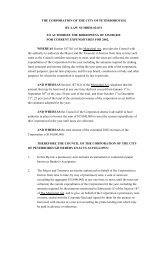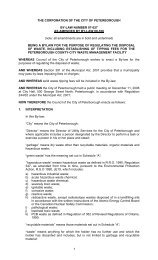Thompson Creek Flood Study Report - City of Peterborough
Thompson Creek Flood Study Report - City of Peterborough
Thompson Creek Flood Study Report - City of Peterborough
Create successful ePaper yourself
Turn your PDF publications into a flip-book with our unique Google optimized e-Paper software.
<strong>Thompson</strong> <strong>Creek</strong> Detailed <strong>Flood</strong> Reduction <strong>Study</strong><br />
<strong>City</strong> <strong>of</strong> <strong>Peterborough</strong><br />
that the gauge level rose by about 5 cm during the event (although the rainfall was<br />
approximately a 1 in 2 year storm). The simulation with HEC-RAS using the<br />
OTTHYMO generated flows (including the storage upstream <strong>of</strong> Armour Road) was<br />
able to reproduce the observed water level at the gauge. The summary output for the<br />
event in included in Appendix I.<br />
For the event <strong>of</strong> July 14 – 15, 2004, it was anticipated that some post-storm high water<br />
marks might be available with which to verify the HEC-RAS model. However, as<br />
indicated by ORCA in the “<strong>Thompson</strong> <strong>Creek</strong> Management Plan” (2004), there was<br />
relatively little impact <strong>of</strong> the storm on <strong>Thompson</strong> <strong>Creek</strong> itself. There were some reports<br />
<strong>of</strong> local drainage issues (at Scollard Drive, Eldon Court, Riverpark Village – see<br />
Appendix B) but no information indicating flooding from the creek itself or <strong>of</strong> water<br />
levels observed. <strong>City</strong> employees recollected that the culvert at Armour Road may have<br />
overtopped for a short time. Simulations <strong>of</strong> the flows and water levels for the event<br />
indicated that levels would have been similar to those for a Regional Storm and Armour<br />
Road would have overtopped. The summary output from HEC-RAS is included in<br />
Appendix I. Based upon this limited evidence, it was concluded that the HEC-RAS<br />
model satisfactorily computes water levels in <strong>Thompson</strong> <strong>Creek</strong>.<br />
4.4.3 OTTSWMM Modelling <strong>of</strong> Local Drainage Systems<br />
As discussed in Section 4.3, within the study area, there are three local drainage<br />
systems which outlet directly into <strong>Thompson</strong> <strong>Creek</strong> and a further six local systems<br />
which drain directly into the Otonabee River. Each <strong>of</strong> these was modelled using the<br />
OTTSWMM model. This tool has the ability to calculate both “major” and “minor”<br />
system flows based upon a description <strong>of</strong> the drainage areas, street layout/width and<br />
storm sewer systems. The “major” system flows are those which travel overland along<br />
the streets, over parking lots, down grassed channels, etc. The “minor” system flows<br />
are those which are contained in the sewer pipes. The model uses a hydraulic<br />
description <strong>of</strong> the catchbasins in the system to determine how much <strong>of</strong> the flow is<br />
actually “captured” by the sewer system and how much remains upon the streets, etc.<br />
This allows analysis <strong>of</strong> whether the pipes are full or not and <strong>of</strong> the depth <strong>of</strong> flow on the<br />
streets and in other overland flow routes throughout the system. Appendix J includes<br />
information on the methods used by OTTSWMM to calculate major/minor flows.<br />
4.4.3.1 Model Development<br />
Drawing No. SS-1 shows the drainage plan, sewer system elements and major system<br />
elements used to create the OTTSWMM models <strong>of</strong> the eight separate local drainage<br />
systems in the study area. The details <strong>of</strong> the models are presented in a series <strong>of</strong> tables<br />
included in Appendix J. The tables include:<br />
14-06605-01-W01 <strong>City</strong> <strong>of</strong> <strong>Peterborough</strong> 50




